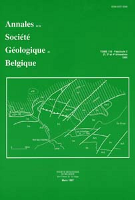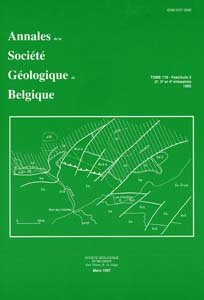- Accueil
- Volume 113 (1990)
- Fascicule 2
- The occurrence of a microbial buildup at Poederlee (Campine Basin, Belgium) : biostratigraphy, sedimentology, early diagenesis and significance for early Warnantian paleogeography
Visualisation(s): 630 (3 ULiège)
Téléchargement(s): 436 (3 ULiège)
The occurrence of a microbial buildup at Poederlee (Campine Basin, Belgium) : biostratigraphy, sedimentology, early diagenesis and significance for early Warnantian paleogeography

Résumé
Le sondage de Poederlee (Bassin de Campine) a été implanté dans une structure en dôme affectant le sommet du Dinantien, reconnue par des études de réflexion sismique. Il a recoupé des calcaires attribués sur base des foraminifères et des coraux au Warnantien inférieur (biosubzones Cf6γ et RC7α,ß).
Deux types de lithofaciès ont été déterminés. Le premier consiste en des bindstones cyanobactériens développés immédiatement sous le niveau d'agitation des vagues et formant le corps d'une construction biohermale; le second type de lithofaciès comprend des packstones et des grainstones bioclastiques déposés dans la zone d'agitation des vagues et qui, surmontant le précédent lithofaciès, forment les flancs et le sommet de l'édifice. Cinq séquences biohermales ont été reconnues dans le sondage et suggèrent l'existence d'un complexe récifal. La comparaison de ces édifices biohermaux avec d'autres connus dans le Warnantien du Bassin de Campine fait ressortir l'influence de leur position paléogéographique sur leur développement.
La diagenèse a commencé avec des calcites fibreuses isopaques et fibro-radiaxiales, qui ont été précipitées à partir d'eaux marines oxydées. Des ciments syntaxiaux (rim cements) se sont développés à partir d'échinodermes dans un fluide capillaire, oxydant à réducteur, ainsi que le montrent leurs caractéristiques en analyse par cathodoluminescence.
Abstract
The Poederlee borehole is situated in the Campine Basin and has been drilled in the center of a domal structure at the top of the Visean, identified by reflection seismic studies. The Visean limestones in this borehole have an Early Warnantian (Late Visean) age. They belong to the Carboniferous foraminifer 6γ subzone and to the rugose coral 7α and ß subzones.
Two types of lithofacies, namely microbial boundstones and bioclastic packstones and grainstones, are present in these limestones. The first type represents the core of a reef mound, which developed below and near the wave base. The second type occurs above the boundstones, forms the flank and top facies of the reef mound and has been deposited above wave base. Five superimposed reef mounds have been recognized in the Lower Warnantian and are interpreted as a reef complex. A comparison of the Lower Warnantian reef mounds in the Campine Basin indicates that the paleogeographical position is a factor which influences their evolution.
Diagenesis started with the precipitation of isopachous fibrous and fibrous radiaxial calcites under oxidizing conditions in marine pore-waters. After the precipitation of the fibrous calcites, dissolution of these cements and of the host limestone possibly occurred in meteoric waters. Rim cements around crinoids and blocky calcites developed in a pore fluid which evolved from oxidizing to reducing.
Pour citer cet article
A propos de : Philippe Muchez
K.U. Leuven, Fysico-chemische geologie, Celestijnenlaan 200C, B-3001 Heverlee, Belgium ; Senior research assistant N.F.W.O.
A propos de : Willy Viaene
K.U. Leuven, Fysico-chemische geologie, Celestijnenlaan 200C, B-3001 Heverlee, Belgium.
A propos de : Jos Bouckaert
Belgian Geological Survey, Jennerstraat, 13, B-1040 Brussels, Belgium ; K.U. Leuven, Historische geologie, Redingenstraat 16bis, B-3000 Leuven, Belgium.
A propos de : Raphaël Conil
Université Catholique de Louvain, Institut de géologie, Place L. Pasteur 3, B-1348 Louvain-la-Neuve, Belgium.
A propos de : Michiel Dusar
Belgian Geological Survey, Jennerstraat, 13, B-1040 Brussels, Belgium.
A propos de : Eddy Poty
Université de Liège, Laboratoire de paléontologie animale, Place du Vingt-Août 7, B-4000 Liège, Belgium.
A propos de : Paul Soille
Distrigaz, Kunstlaan 31, B-1040 Brussels, Belgium.
A propos de : Noël Vandenberghe
K.U. Leuven, Historische geologie, Redingenstraat 16bis, B-3000 Leuven, Belgium.






